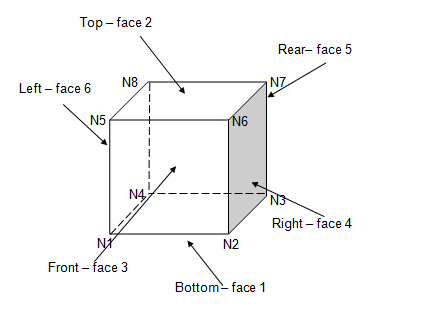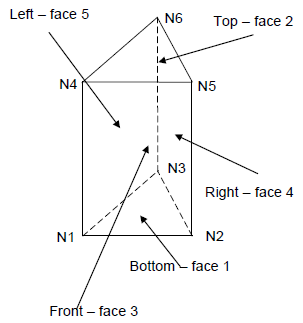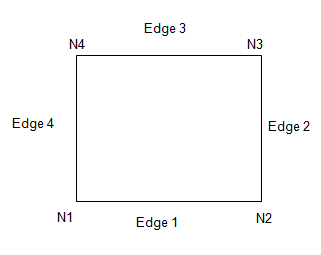Card 9 - FREEFACE Element Free Face Generation
This optional card generates elements on the faces or edges of specified elements and assigns them a group name.
Parameters: KODE, N1, T1, T2, T3, T4, T5, T6, T7, T8, T9
N1
N1 is a group name. The elements generated by this card will be assigned this group name.
T1
T1 is a flag = 0 or 1. T1 = 0 means the element generated by this card cannot radiate, T1 = 1 means they can. If the generated elements are beams or lump masses, they cannot radiate.
T2 to T9
T2 is an element number on whose face/edge an element is to be generated.
T3 is the face/edge number associated with element T2.
T4 is an element number on whose face/edge an element is to be generated (optional).
T5 is the face/edge number associated with element T4.
T6 is an element number on whose face/edge an element is to be generated (optional).
T7 is the face/edge number associated with element T6.
T8 is an element number on whose face/edge an element is to be generated (optional).
T9 is the face/edge number associated with element T8.
Notes
This card generates elements on the faces or edges of specified elements. The generated elements are all assigned the group name N1, which may be used in the same way as other group names defined on the Card 9 NAME Cards.
The orientation of shell elements generated on faces of solid elements is such that the shell elements face outwards. This allows them to radiate, provided the underlying element has a proper emissivity defined, and provided the generated element is not flagged as non-radiating with a Card 9 PARAM NORAD Card. Shell elements generated between two solid elements, beams, and lump masses cannot radiate.
In case an element already exists on a specified face, a new element will not be created. Instead, the existing element will be added to the group N1.
If multiple FREEFACE requests exist for the same element face, only a single element will be generated, and it will be added to all the specified group names.
A generated beam is assigned a surface area equal to the thickness of the underlying shell, and a generated lump mass is assigned the surface area of the underlying beam. If the generated beam or lump mass is connected to more than one element, it is randomly assigned the surface area of one of the underlying elements.
The numbering convention for the free faces and edges in relation to the nodes is described in the following images.
 |
 |
 |
 |
